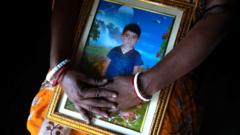Every day, three children tragically lose their lives to drowning in India, particularly in the Sundarbans, where mothers take initiatives to safeguard the youngest members of their community.
Mothers Unite to Combat Childhood Drowning in India's Sundarbans

Mothers Unite to Combat Childhood Drowning in India's Sundarbans
A heartbreaking increase in child drownings prompts collective action among mothers in West Bengal's Sundarbans region.
Mangala Pradhan will never forget the morning she lost her one-year-old son Ajit 16 years ago in the unforgiving wetlands of Sundarbans, a vast delta of islands in West Bengal. It was an ordinary day, and while Mangala busied herself with chores, her curious son slipped away unnoticed and drowned in the family pond. This tragedy is echoed in countless households across this region, where daily life intertwines dangerously with water.
Today, Mangala is one of 16 mothers involved in makeshift creches established by the non-profit Child In Need Institute (CINI). These creches are critical in looking after about 40 children whose parents are working. "These mothers are the saviors of children who are not their own," says Sujoy Roy of CINI, stressing the urgency for such care as drownings continue unabated in this riverine area, filled with ponds that double as water sources.
A 2020 survey from the George Institute and CINI unveiled a grim statistic: about three children aged one to nine drown every day in the Sundarbans. The drownings peak during the rains, especially between 10 AM and 2 PM when caregivers are preoccupied with tasks and children roam unsupervised. Alarmingly, around 65% of drowning incidents occur within 50 meters of home.
In response to these tragedies, mothers like Sujata Das, who lost her 18-month-old daughter Ambika in a pond three months ago, are advocating for preventative measures such as fencing ponds with bamboo and netting. She urges her neighbors to learn CPR to provide critical aid in emergencies.
Yet, the path to preventative measures is fraught with challenges. Superstitions about angering water deities hinder initiatives like pond fencing. This is a reality not only in India but also in neighboring Bangladesh, where wooden playpens failed to effectively protect children. Innovative programs have dramatically reduced drowning rates in Bangladesh, inspiring hopes for similar solutions in the Sundarbans.
Education and community awareness are crucial, especially as drowning remains a leading global cause of death among children. In 2021 alone, approximately 300,000 people drowned worldwide, a statistic that includes a significant number of children. Sadly, the government of India reported around 38,000 drowning fatalities in 2022, although the real figure is likely much higher.
In this context, the creches serve as a vital lifeline. They are spaces where children can safely stay away from the dangers of the ponds while their parents work. Creative solutions and community resilience are becoming imperative in preventing future tragedies.
Sharing her plea with other mothers, Kakoli Das, who lost her six-year-old son Ishan in a drowning incident last summer, urges: "Please, fence your ponds, learn how to revive children, and teach them how to swim. We cannot afford to wait."
As these mothers fight for safer futures for their children, they also enrich their community, singing songs that instill lessons of caution and survival. “I won’t go to the pond alone, unless my parents are with me,” three-year-old Manik Pal sings, highlighting both hope and the urgency of their mission.
Today, Mangala is one of 16 mothers involved in makeshift creches established by the non-profit Child In Need Institute (CINI). These creches are critical in looking after about 40 children whose parents are working. "These mothers are the saviors of children who are not their own," says Sujoy Roy of CINI, stressing the urgency for such care as drownings continue unabated in this riverine area, filled with ponds that double as water sources.
A 2020 survey from the George Institute and CINI unveiled a grim statistic: about three children aged one to nine drown every day in the Sundarbans. The drownings peak during the rains, especially between 10 AM and 2 PM when caregivers are preoccupied with tasks and children roam unsupervised. Alarmingly, around 65% of drowning incidents occur within 50 meters of home.
In response to these tragedies, mothers like Sujata Das, who lost her 18-month-old daughter Ambika in a pond three months ago, are advocating for preventative measures such as fencing ponds with bamboo and netting. She urges her neighbors to learn CPR to provide critical aid in emergencies.
Yet, the path to preventative measures is fraught with challenges. Superstitions about angering water deities hinder initiatives like pond fencing. This is a reality not only in India but also in neighboring Bangladesh, where wooden playpens failed to effectively protect children. Innovative programs have dramatically reduced drowning rates in Bangladesh, inspiring hopes for similar solutions in the Sundarbans.
Education and community awareness are crucial, especially as drowning remains a leading global cause of death among children. In 2021 alone, approximately 300,000 people drowned worldwide, a statistic that includes a significant number of children. Sadly, the government of India reported around 38,000 drowning fatalities in 2022, although the real figure is likely much higher.
In this context, the creches serve as a vital lifeline. They are spaces where children can safely stay away from the dangers of the ponds while their parents work. Creative solutions and community resilience are becoming imperative in preventing future tragedies.
Sharing her plea with other mothers, Kakoli Das, who lost her six-year-old son Ishan in a drowning incident last summer, urges: "Please, fence your ponds, learn how to revive children, and teach them how to swim. We cannot afford to wait."
As these mothers fight for safer futures for their children, they also enrich their community, singing songs that instill lessons of caution and survival. “I won’t go to the pond alone, unless my parents are with me,” three-year-old Manik Pal sings, highlighting both hope and the urgency of their mission.





















